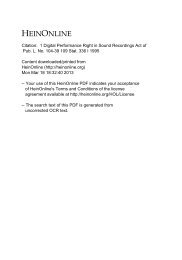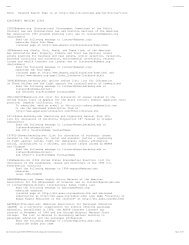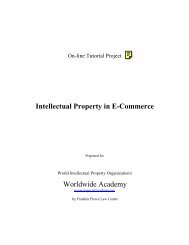BIEDERMANN MOTECH GMBH and Depuy Spine, Inc, Plaintiffs
BIEDERMANN MOTECH GMBH and Depuy Spine, Inc, Plaintiffs
BIEDERMANN MOTECH GMBH and Depuy Spine, Inc, Plaintiffs
Create successful ePaper yourself
Turn your PDF publications into a flip-book with our unique Google optimized e-Paper software.
claim construction. It is merely a presumption which can be overcome if, for example, claim differentiation<br />
would impermissibly broaden claims beyond their correct scope. Curtiss-Wright, 438 F.3d at 1381. In such<br />
a situation, the correct scope of patent claims can be determined by looking to the overall context of the<br />
specification, looking to the presence of disclaimers in the specification or prosecution history, etc.<br />
It is a long-st<strong>and</strong>ing rule that snippets of language describing the preferred embodiment should not be read<br />
into the claims. Comark Commc'ns, <strong>Inc</strong>. v. Harris Corp., 156 F.3d 1182, 1186-87 (Fed.Cir.1998). But it is<br />
not picking snippets from descriptions of the preferred embodiment when the Court recognizes that the<br />
inventors consistently use claim language in particular ways. Rather, it is reading the language of the<br />
patents, as written by the inventors, in a consistent fashion. Inferring that a word in claim language has a<br />
particular meaning does not require extrapolating limitations from the preferred embodiments, which is<br />
forbidden. The practice of deducing meaning from all the intrinsic evidence including distinctions made by<br />
the inventors in their choice of language is acceptable. See Nystrom v. TREX Co., 424 F.3d 1136, 1144<br />
(Fed.Cir.2005) (consistency of language in specification is acceptable basis for claim construction).<br />
Nystrom concerned a patent on boards used for outdoor decking. The boards were designed to fit together to<br />
form a comfortable surface for walking upon <strong>and</strong> to effectively shed rainwater. Id. at 1140. The issue in<br />
Nystrom was whether the term "board" was limited to conventional wooden boards cut from a log. Id. at<br />
1142. The alternative would be some sort of manufactured board, e.g., pressed together from plastic <strong>and</strong><br />
wood fiber. Id. at 1140. Such manufactured boards were well known to those employed in the decking<br />
business. The patentee in Nystrom argued that it was error for the district court to rely on statements in the<br />
specification <strong>and</strong> prosecution history to limit the claim to conventional wooden boards because there was no<br />
clear avowal of claim scope in the specification or prosecution history Id. at 1142. Unfortunately for the<br />
patentee in Nystrom, the specification <strong>and</strong> prosecution history were entirely consistent with i the notion that<br />
the patent was limited to boards cut from a log. Id. at 1144-45. Because there was no notice in the intrinsic<br />
record to support a broader meaning of "board," the patentee was no entitled to the broader meaning. Id. at<br />
1145.<br />
There is an additional fact about Nystrom which is notable for this case. The Federa Circuit issued a<br />
different opinion coming to the opposite conclusion in Nystrom before Phillips came down, which was<br />
subsequently withdrawn in favor of the opinion cited above. Nystrom v. Trex Co., 374 F.3d 1105, 1110-11<br />
(Fed.Cir.2004). In this earlier opinion, the Federal Circuit ha no trouble finding a broad definition for<br />
"board" given that there was no clear disavowal of claim scope in the patent or prosecution history. Thus,<br />
one lesson for district courts is that after Phillips, it is not necessary to find clear disavowal of claim scope<br />
in order to define the claims words narrowly. A comparison of the two Nystrom opinions shows that<br />
arguments which rely heavily on extrinsic evidence to support broad definitions of claim terms are simply<br />
not viable after Phillips.<br />
Another principle of claim construction is that there is a long established rule that claims should be<br />
interpreted in a way that preserves their validity, if it is possible to do so consistently with the language<br />
chosen by the inventors. Klein v. Russell, 19 Wall. 433, 86 U.S. 433, 466, 22 L.Ed. 116 (1873). In<br />
particular, claims should be interpreted to be consistent with the enablement <strong>and</strong> written description<br />
requirements. The enablement requirement is that the patent specification must describe how to make <strong>and</strong><br />
use the invention "in such full, clear, concise, <strong>and</strong> exact terms as to enable any person skilled in the art to<br />
which [the patent] pertains ... to make <strong>and</strong> use the invention." 35 U.S.C. s. 112. Although a patent<br />
specification need not explicitly disclose every variation of the invention claimed by the inventor, the<br />
disclosure must be complete enough that a person of ordinary skill in the art, at the time the patent






